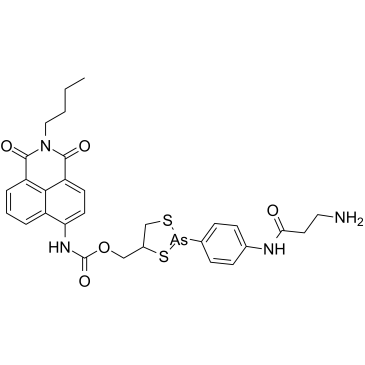| Description |
NEP (VDP-green (NEP)) is a turn-on fluorescent probe based on the intramolecular charge transfer (ICT) mechanism for sensing vicinal dithiol-containing proteins (VDPs). NEP is exhibits high selectivity toward VDPs in live cells and in vivo and displays a strong green fluorescence signal (λex/λem=430/535 nm). NEP has the potential for parkinsonism[1].
|
| Related Catalog |
|
| In Vitro |
NEP (1-30 μM; 6 hours) has no or little cytotoxicity in HepG2 and PC12 cells[1]. NEP (10 μM; 4 hours) causes the fluorescence intensity to decrease gradually in PC12 cells pretreated with 6-OHDA (0, 50, 100, and 200 μM; for 30 min)[1]. NEP contains a dithiarsolane moiety (five-membered As-S ring) as the receptor of VDPs. In the presence of VDPs, NEP displays a strong green fluorescence signal produced by the cyclic dithiarsolane cleavage and subsequent intramolecular cyclization to liberate the fluorophore. NEP maintains a reliable fluorescence response within the range of pH 7-10[1].
|
| In Vivo |
NEP (10 μM; for 4 h) causes the obvious green signal in zebrafishes (4 day old)[1].
|
| References |
[1]. Guodong Hu, et al. Decrease of Protein Vicinal Dithiols in Parkinsonism Disclosed by a Monoarsenical Fluorescent Probe. Anal Chem. 2020 Mar 17;92(6):4371-4378.
|
